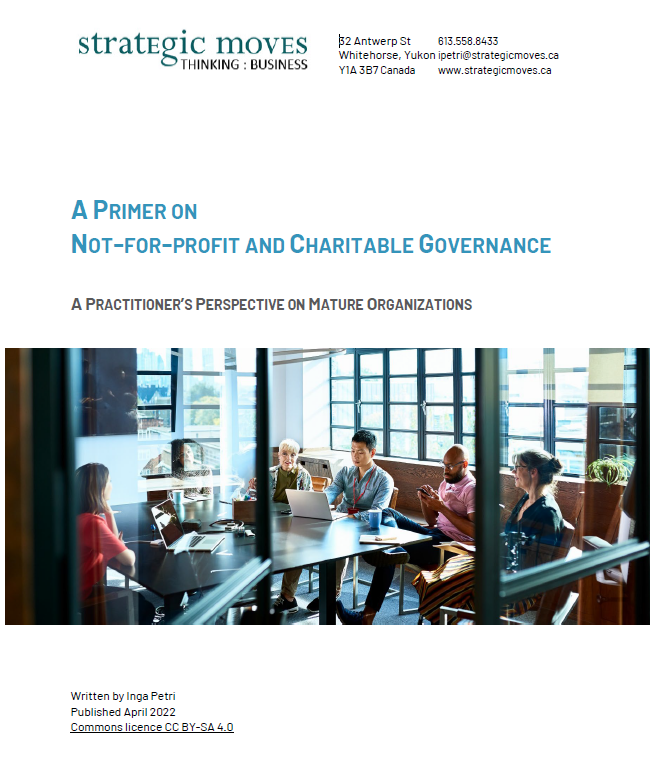A sector analysis series #1
Creative Commons Licence CC BY-SA (i.e. use in any way you want with attribution of source: “Inga Petri, Strategic Moves, May 17, 2020”)
Public health officials in Canada ordered dine-in restaurants closed everywhere during March 2020. Now in mid-May, they are musing about reopening restaurants with new obligations, centred on 2 metre distancing, disinfecting surfaces and perhaps more.
That potential “permission” to “open” cannot result in thinking restaurants and their owners wouldn’t require continued financial support.
The reality check
2018 financial data from Statistics Canada available at http://www.ic.gc.ca/eic/site/pp-pp.nsf/eng/home shows that for the 35,514 full-service restaurants with sales between $30,000 to $5 million (data for those earning above $5 million is suppressed):
- 35% did not generate any profit at all, i.e. they were operating at a loss.
- The other 65% turned a profit of 7.6% on average, representing $24,400 for the year.
That means a profitable restaurant in Canada makes money only 4 weeks out of 52 on average. It also means a restaurant owner’s average annual profit is less than minimum wage. And no, many sole proprietors do not pay themselves a regular wage; instead keeping everything working in their business. Anyone can see the high risk restaurateurs take and how tenuous their existence is.
In the Yukon, where I live, the numbers are a little better: only 22% do not report any profit and of the 78% that do, the average profit is 9.3% representing $66,000 on average in 2018. Nonetheless these figures show how little slack there is and how all the money for the years comes from the now cancelled summer tourist season.
This data makes clear: the average restaurant, closed down already for two months due to the public health orders, is already bankrupt. Re-opening obligations are shaping up to be costly and won’t result in lower staffing complements despite serving far fewer customers due to new labour intensive cleaning regimes. There is simply no economic case to reopen for the great majority of dine-in restaurants.
Significant direct contributions to Canadians
Through the risk borne by them, restaurateurs have been contributing far-reaching benefits to Canada’s economy: according to Government of Canada data, the average dine-in restaurant had $765,600 in sales. Of that $250,300 went to labour costs and wages. Purchases and materials that are part of the cost of goods sold totalled $273,900. Rent accounted for $65,300 and so on.
And there are many more indirect, restaurant owners have been building communities, contributed to quality of life, played a large part in attracting and retaining a skilled workforce, growing tourism through the culinary arts and memorable dining experiences, supporting charities, paying staff, helping put young people through school, feeding people, all while breaking their backs and bank accounts.
In short, the direct and related economic activity generated by the restaurant sector is worth billions to Canadians and the Canadian economy.
A broken model – Restaurateurs need help
COVID-19 is showing for the world to see what has been true for some time: The business model independent full-service restaurants have been forced into, largely by price competition from other food sector players, is broken and the owners are broke.
The numbers also make clear why restaurants can fall into GST and Payroll remittance tax debt, when basic break-even is so difficult to achieve. Non-remittance incurs extraordinary penalties and interest charges that can take up any monthly surplus and more. And then they are exposed to the CRA’s relentless collections and being treated as less than valuable community builders and hard-working, creative, innovative business leaders.
They need a chance at a life beyond COVID-19 and beyond a broken business model.
How can Canada help restaurants and their owners now?
A few ideas that could pull restaurants and restaurateurs back from the brink:
- Consumers have to learn to pay much more for the pleasures of eating out, especially when they don’t wish to tip 20% for servers and rather see living wages for restaurant workers, rather than below minimum wage as is the case in some jurisdictions. In the Yukon where I live it appears as though most, if not all, workers in the restaurant industry earn well above minimum wage plus tips.
- Landlords should permanently slash rents to restaurant tenants to enable restaurant owners earning a living wage and being able to invest in innovations in their business or business model.
- In addition to short-term COVID-19 Transition Grants to pay for additional public health mandated expenses and staff training, Government has to consider providing meaningful tax debt relief to allow a fresh start or at least some peace for owners.
- Sole proprietors must be considered as a special group requiring assistance. If sole proprietors are considered as “making a profit” when they barely break even before paying themselves anything, their work translates into not being able to cover their personal expenses and falling into debt.
- Local governments should revisit their zoning requirements to enable new, innovative ways of providing food services to the public. They can range from quickly enabling sidewalk patios and taking over unused parking spaces (no tourists means ample parking spaces are unused); a new breed of home-based businesses offering nano-scale/single-table/prepared-food eating experiences without the massively expensive requirements for home-based commercial kitchens; significantly reducing restaurant and liquor licensing costs.
- Canada’s provincial and territorial government-owned and run Liquor Control Boards should look at offering higher discounts or find a way to return most of their profits to their customers, i.e. bars and restaurants that must purchase alcohol at government controlled prices; allowing off-sales within every restaurant liquor license during the COVID shutdown period and 3 months beyond.
COVID-19 relief has been fast and effective at saving the financial lives of millions of Canadians. It is time to save the lives of those Canadians who have been living under the unyielding pressures of low price competition while the market demands quality food and high quality, unique dining experiences.


